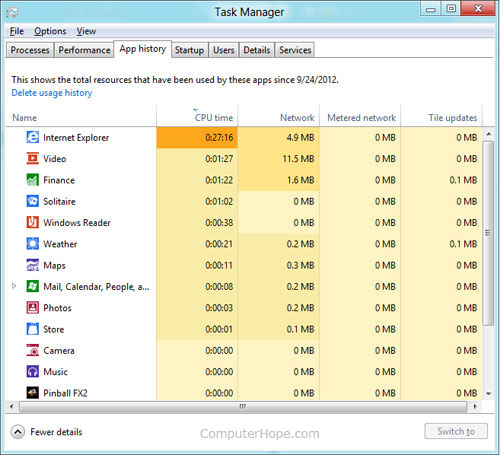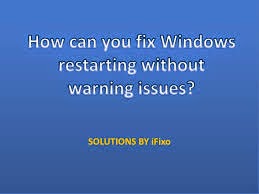Update to Windows 8.1
Microsoft has released Windows 8.1, which is a
free upgrade for anyone running Windows 8. This update addresses many of
the problems users have had with Windows 8 and also adds a Start
button. Visit Microsoft's Windows 8.1 page for the update.
Customize your tiles
Make the most of your Windows Start screen tiles by adjusting the sizes, where they are located, and what is listed.
- Move
any tile by clicking and dragging the tile. While moving a tile, if you
need a larger view of the Start screen move the tile towards the top or
bottom of the screen to zoom out.
- Use your mouse wheel to scroll left-to-right through your tiles.
- Any Desktop shortcut or program can be pinned to the Start screen by right-clicking the icon and choosing Pin to Start.
- In
the bottom right-hand corner of the start screen is a magnifying glass
with tiles, click this icon to get a zoomed out view of your Start
screen. In this view, if you right-click on a group of tiles you'll be
given the option to name group, which can be useful if you have a
group of related tiles (e.g. games). In this view, you can also click
and drag a group to organize your tile groups.
- Create a new speed bump between tile groups by moving a tile to a speed bump.
- Resize any User tile or Live tile by right-clicking the tile and choosing resize.
- If there is a tile you want on your Taskbar, right-click the tile and choose Pin to taskbar.
- Show
admin applications on the Start screen by clicking Settings in Charms,
click Settings, and change the Show administrative tools from No to Yes.
- In Internet Explorer 10, you can also pin any of your favorite web pages to your Start Screen.
Windows 8 keyboard shortcuts
Knowing at least some of the Windows 8 keyboard
shortcuts helps make your Windows 8 experience much more enjoyable. Try
to memorize these top Windows 8 shortcut keys.
- Press the Windows key to open the Start screen or switch to the Desktop (if open).
- Press the Windows key + D opens the Windows Desktop.
- Press the Windows key + . to pin and unpin Windows apps on the side of the screen.
- Press the Windows key + X
to open the power user menu, which gives you access to many of the
features most power users would want (e.g. Device Manager and Command
Prompt).
- Press the Windows key + C to open the Charms.
- Press the Windows key + I to open the Settings, which is the same Settings found in Charms.
- Press and hold the Windows key + Tab to show open apps.
- Press the Windows key + Print screen to create a screen shot, which is automatically saved into your My Pictures folder.
See our Windows shortcuts page for a full listing of all Windows shortcuts.
Know your hot corners
The corners on your screen are hot corners and
give you access to different Windows features. Below, is a brief
explanation of each of these corners.
Bottom Left-hand corner
The
bottom left-hand hot corner of the screen allows you to access the
Start screen, if you're in the Start screen and have the Desktop open,
this corner opens the Desktop from the Start screen.
Tip: Right-clicking in the left hand corner opens the power user menu.
Top-left corner of the screen
Moving
the mouse to the top-left corner and then down displays all the apps
running on the computer. Clicking and dragging any of these apps to the
left or right-hand side of the screen will snap that app to that side of
the screen. Each of these open app icons can also be right-clicked to
close or snap.
Right-hand side of the screen
On the full right-hand side of the screen will be given access to the Windows Charms.
Taking advantage of search
The Search in Windows 8 has been significantly
improved when compared to all previous versions of Windows. To search
for a file or run a program in Windows 8 from the Start screen just
start typing what you're trying to find or want to run.
As you begin typing, the results will start appearing on the left-hand
side. In addition to being able to search for files and run programs,
the Search also supports limiting the search to apps such as Finance,
People, Maps, Photos, Mail, Music, Videos, Weather, and much more. If
what you are searching for is not a file or program, click on the app
you want to use as the search. For example, if you were searching for
"New York" and selected the Weather App you would be shown the weather
in New York, NY.
By default, Search organizes the
available Apps by how frequently they are used and then in alphabetical
order. If you want to keep your favorite app at the top of the Search
list, right-click the app and choose Pin. Pinning the app will lock it
in place regardless of how often it is used. If there is an app you
don't want (e.g. Finance) you can turn on and off any of the search apps
through the PC settings, which is found under the Settings in the Charms.
Bonus tip: The Search is also found through Charms and can also be opened by pressing Windows key + F.
Running two apps side by side
Any app can be pinned to the left or right-hand side of the screen. For example, open the People app and then press the Windows Key + . (period)
to move that app to the right-hand side of the screen, pressing the
same keys again will move it to the left-hand side, and pressing the
same keys again makes it full screen. While an app is pinned, any other
app or program can be opened and loaded into the available space on the
screen. For example, in the picture below, we've opened a browser window
and have the People app running to monitor our social networks.
Any open app can also be pinned using your mouse by clicking at the top
of the tile and dragging it to the left or right-hand side of the
screen.
Bonus tip: The Desktop can also be pinned to the left or right-hand side of the screen.
Note: In order for snap to work properly your resolution must be at least 1,366 x 768.
Windows 8 Task Manager
The Windows 8 Task Manager
has been significantly improved over previous versions of Windows. Some
of the new changes include showing a total percent usage at the top of
your Processes, which makes it easier to determine total memory and CPU
usage, improved Performance graphs, a Startup tab to see startup
processes and their impact to system performance, and the App history
tab (as shown below) that gives you the total resources an app has used
over a period of time. Press Ctrl + Shift + Esc to start exploring the new Task Manager.
Use a picture password to log into your computer
Windows 8 includes a new feature called Picture password,
which allows you to authenticate with the computer using a series of
gestures that include circles, straight lines, and taps. Enable this
feature if you want a new way to access your computer or have a hard
time with passwords.
- Open the Windows Charms.
- Click Settings and then More PC settings
- In the PC settings window click Users and then select Create a picture password
Bonus tip: A four digit pin password can also be created and used to access your computer.
Take advantage of Windows 8 apps
Windows 8 comes included with several apps to
help you get the most from your computer. Below are just a few of the
included apps.
People
Microsoft
touts the People feature in Windows 8 because they understand how many
people are using social networks today. In the People feature you'll be
able to connect your Windows computer to all the major social networks
including Facebook, LinkedIn, and Twitter.
Once connected, you can pin the people app and monitor your social
network (as shown below), use People in Search to find people, and get
an overview of what is happening in all your social networks.
Reader
The Reader app gives you PDF support right out of the box.
SkyDrive
The SkyDrive app gives you access to the Microsoft cloud service SkyDrive, which allows you to store your photos, documents, and other files in the cloud and access or share those files with any computer with Internet access.
Store
Take advantage of the Windows Store and install one or more of the
thousands of available apps designed for Windows 8. The Store is found
in the Start screen, or use Search to search the Store app for any apps
that you are trying to find.
Know the answers to common questions
Windows 8 is the biggest change to Microsoft
Windows since the introduction of Windows 95, which was released all the
way back in 1995.
Since so many people have grown up with Windows, it can be difficult to
transition to a new way of doing things. Below, is a short list of the
most common questions previous Windows users have.
- How can I close an app in Windows 8?
- How do I sleep, restart, or shut down Windows 8?
- How do I get the start button back in Windows 8?
Know the Jargon
Knowing all the new jargon introduced with
Windows 8 help improve your familiarity with Windows 8 and make it a
more enjoyable experience. Below, are just a few links to the most
commonly used Windows 8 terms.
- Charms
- Lock screen
- Picture password
- Pin
- Power User Task Menu
- Snapped app
- Speed bump
- Start screen
- Tile, User Tile, and Live Tile
- Windows Store
















 Computer viruses such as the blaster virus
are written to reboot your computer without warning. Usually these
viruses make the computer reboot every 5, 10, 15 or 30 minutes after the
computer has booted.
Computer viruses such as the blaster virus
are written to reboot your computer without warning. Usually these
viruses make the computer reboot every 5, 10, 15 or 30 minutes after the
computer has booted.


